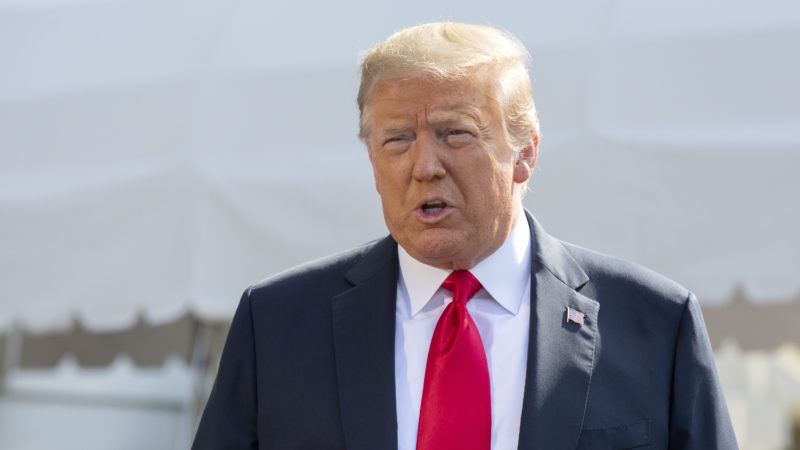Trump Worries That More Coronavirus Testing Makes America Look Bad
Testing provides clarity and critically useful evidence about the spread of the disease that the president doesn’t seem to want.

The single biggest failure of the Trump administration's response to the coronavirus was the delayed rollout of testing, which left both policy makers and the public flying blind for months on end, unable to gauge the extent of the virus's spread, and thus flailing in response. Testing provides clarity, evidence, and critical information without which an effective response cannot be devised.
The Centers for Disease Control and Prevention repeatedly botched the development and delivery test kits, and the Food and Drug Administration wasted precious early weeks before approving private companies to deploy their own tests, as other countries had already done successfully, and as former Trump administration health officials had proposed early on.
This set of failures can be blamed at least in part on bureaucratic inertia and agency culture, in particular on the prevailing belief inside the U.S. health apparatus that the federal government should serve as a centralized clearinghouse for testing. The desire to serve as a single point of control meant that federal health agencies ended up being a single point of failure.
That failure that had predictably catastrophic results, for it meant that U.S. officials had limited visibility about the spread and nature of the disease. If more testing capacity had been deployed earlier, government officials—as well as private companies and individuals—would have been better equipped to respond to the virus. Indeed, testing continues to be an area where the U.S. has sometimes fallen short; although nationwide testing capacity has risen to about 500,000 per day, which many experts consider an important benchmark, some states are still struggling with their testing regimes.
Yet in President Donald Trump's telling, more testing is actually a problem. In an interview with the Wall Street Journal last week, Trump said he "personally think[s] testing is overrated" and that, because more testing reveals more confirmed cases, "in many ways, it makes us look bad." Trump repeated a version of this opinion at a campaign rally over the weekend, saying, "When you do testing to that extent, you're going to find more people, you're going to find more cases. So I said to my people, 'Slow the testing down, please.'"
This comment understandably raised questions about whether Trump had, in fact, intentionally slowed down testing in order to preserve the appearance of less viral spread.
Trump's flacks argued that he was merely joking. "It was a comment that he made in jest," said White House Press Secretary Kayleigh McEnany on Monday. Trump, however, quickly insisted otherwise. When reporters asked him yesterday whether the remark was meant as a joke, he said, "I don't kid. Let me just tell you. Let me make it clear," adding once again that more testing means finding more cases.
The White House spent yesterday saying this was a joke. https://t.co/IJclTEQhra
— Jake Sherman (@JakeSherman) June 23, 2020
(As is often the case with Trump, it's not clear whether his words have resulted in any actions, or whether they were merely an empty threat. Talking Points Memo reports that the administration is moving to end federal support for some testing sites. Anthony Fauci, director of the National Institute of Allergy and Infectious Diseases, meanwhile, has told Congress that testing has not slowed down, and in fact is on track to increase. Meanwhile, total case numbers are up across the country, but deaths, while still high, are trending downward on a daily basis.)
It is true that all else being equal, a much broader testing regime will mean finding and confirming more cases. And some reports of rising cases have mistakenly been based on the deployment of more widespread testing. It is probable, however, that the recent rise in confirmed cases is not solely a result of increased testing, but a result of increased viral spread and an outbreak that remains uncontrolled, as evidenced by the rising positive test rate in states like Arizona and Florida.
But these nuances are mostly irrelevant in this instance since Trump's personal view appears to be altogether simpler—and more troubling.
Trump's remarks over the last week make clear that he sees increased testing negatively simply because it results in a higher number of confirmed cases, which makes the country look bad. Nor is this a new view for Trump; in March, he pushed to keep the passengers of a cruise ship where the virus had broken out quarantined because allowing them to disembark would raise the country's official infection count. "I like the numbers being where they are," he said.
What Trump has repeatedly communicated is that he dislikes testing precisely because it makes clear the scope of the problem; his frustration is with the evidence and information testing provides.
He appears to be irritated by the idea of object permanence, the notion that something that can't be seen at the moment yet still continues to exist. But just as cancer does not go away if you do not test for it, and the world does not disappear if you close your eyes, slowing the pace of testing does not actually reduce the spread of the disease, even if official confirmation numbers do not go as high.
Refusing to look at the full extent of a problem does not make the problem go away. Instead, it limits our ability to see its spread and understand its consequences. That ability was already dangerously crippled by a series of bureaucratic failures, which have largely (though not entirely) been corrected. What is still worrying is that the president is saying he would rather we all be flying blind.


Show Comments (137)